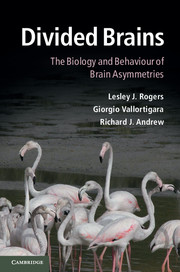1 - Introduction
Published online by Cambridge University Press: 05 February 2013
Summary
Once the emperor Hui Tsung was enjoying the sight of a lichee tree laden with fruit before the palace when a peacock approached the tree, and he summoned his artists at once to make a picture. They produced a magnificent painting of the peacock with its right foot poised to take a step on a flower-bed: but to their surprise the emperor shook his head over it. A few days later when he asked if they had discovered their mistake, they had no answer ready. Then Hui Tsung told them: ‘A peacock always raises its left foot first to climb.’
Cheng Chen-To, Chang Heng and Hsu Pang-Ta (1957)Summary
Once thought to be unique to the human brain, lateralization of structure and behaviour is now known to be widespread in vertebrates and, furthermore, it has a similar plan of organization in the different species. This chapter introduces the basic pattern of lateralization of vertebrate species and does so in a historical context to highlight the fact that, until some 20 years ago, it was widely and incorrectly assumed that having a lateralized brain was a mark of the cognitive superiority of humans. It also introduces some of the new evidence showing the presence of lateralization in invertebrate species.
Information
- Type
- Chapter
- Information
- Divided BrainsThe Biology and Behaviour of Brain Asymmetries, pp. 1 - 34Publisher: Cambridge University PressPrint publication year: 2013
